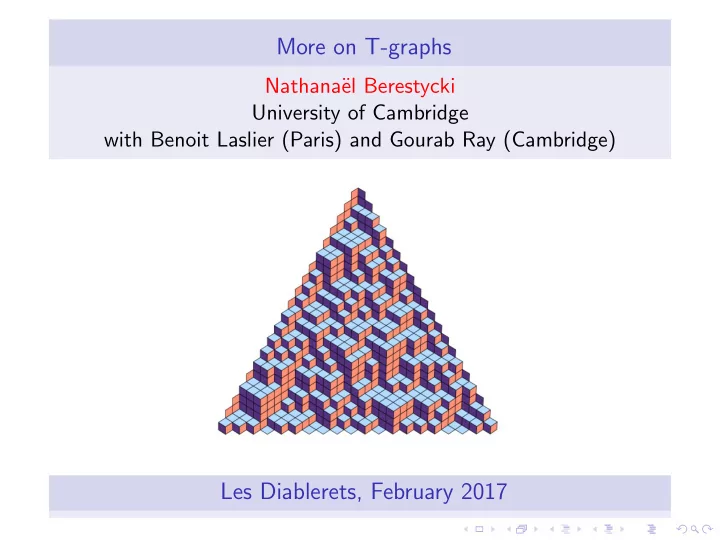

More on T-graphs Nathana¨ el Berestycki University of Cambridge with Benoit Laslier (Paris) and Gourab Ray (Cambridge) Les Diablerets, February 2017
Motivation: what is the point of T-graphs? Temperley bijection UST on graph G to dimer on graph G ′ . But given dimer on graph G (say hexagonal lattice H ), can one find a tree (on a different graph)? T-graphs Extend the Temperley bijection to dimer on H . (Gibbs measure) Dimer on H ↔ UST on T-graph.
Gibbs measures on H . What are the possible translation invariant Gibbs measures for dimers on H ? Theorem (Sheffield) ∀ p a , p b , p c in (0 , 1) such that p a + p b + p c = 1 , ∃ ! ergodic transl. inv. Gibbs measure on lozenge tilings of C : N-S lozenge → p a NE-SW lozenge → p b NW-SE lozenge → p c .
Where do T-graphs come from? Question (Kenyon-Sheffield): Is there a tree on a graph G such that: - UST on G “gives” dimer configuration µ p a , p b , p c on H - Winding of UST gives height function? Ans: T-graph!
Height function Definition How to define height function h # δ on a general graph? Ans: weighted count of dimers along path from reference point. View dimer M as flow: 1 Each blue sends one unit to red along dimer edge: ω M ( e ) = 1.
Height function 2 To define height function: Let φ be any reference flow, let θ = ω M − φ . Div( θ ) = 0 So if θ † = dual flow, Rot( θ † ) = 0. Hence θ † = ∇ h , h = height function (defined on faces).
Definition Let p a , p b , p c . Let ∆ = triangle with angles π p a , π p b , π p c . Let a α = � AB , b β = � BC , c γ = � CA , where a , b , c > 0, α, β, γ ∈ C . Let λ ∈ C , | λ | = 1 ( ≈ translation parameter) Def of flow on oriented edges between w and b : � α ) − n ( w ) � λ − 1 ( β γ ) − m ( w ) ( β αλ ( β γ ) m ( b ) ( β α ) n ( b ) , φ ( wb ) = ℜ and φ ( bw ) = − φ ( wb ), where m , n are coordinates of b/w: a b c
This defines a dual flow φ † on H † . Claim Rot φ † = 0. Check: fix w white vertex. Let b 1 , b 2 , b 3 around: b 3 = ( m − 1 , n + 1) b 2 = ( m, n + 1) c b w = ( m, n ) a b 1 = ( m, n ) � α ) − n ( w ) � λ − 1 ( β γ ) − m ( w ) ( β αλ ( β γ ) m ( b ) ( β α ) n ( b ) , φ ( wb ) = ℜ
So φ † = ∇ ψ for some function ψ : H † → C . T is defined to be ψ ( H † ).
More useful: how to think about it? ψ (white triangle) = scaled, rotated copy of ∆. Each black face is projected into a segment. λ ≈ translation on T-graph. Choosing λ ∼ Leb: ≈ choosing a “uniform” far away vertex.
White triangles mapped to copies of ∆: can be arbitrarily small, but not arbitrarily big. Black triangles mapped to segments segments are bounded below and above.
The reference flow on T We need to define carefully a reference flow on T-graph. Let w , b be two adjacent white/black triangles. v 1 , v 2 = two vertices on both sides of ψ ( b ) ∩ ψ ( w ). S 1 , S 2 = two segments containing v 1 , v 2 in their interior. θ 1 , θ 2 = angles of S 1 , S 2 wrt ψ ( b ) (opp. ψ ( w )).
Why is this a flow? θ 5 θ 4 θ 1 θ 3 + θ 4 2 π 2 π θ 5 + θ 6 θ 2 2 π 2 π θ 3 θ 4 θ 6 θ 1 + θ 2 θ 1 θ 2 2 π θ 3 θ 3 + θ 4 θ 1 2 π θ 2
Orientation, spanning forests, dimers Orientation Any black vertex b is the interior of some segment S . A RW at b can only move to two extremities of S . Spanning forest Meaning each vertex has a unique outgoing edge; no cycle (ignoring orientation) Then each component has a unique path to ∞ . Dual spanning forest Let F † = dual spanning forest. Each component must be infinite. Orient F † towards some root. If F is one-ended tree, then so is F † , so no choice to be made
Orientation, spanning forests, dimers Dimers ↔ Spanning forest Let w be white vertex. Then put a dimer edge between w and unique outgoing edge in F † from ψ ( w ). Note that height function will be winding.
Recommend
More recommend